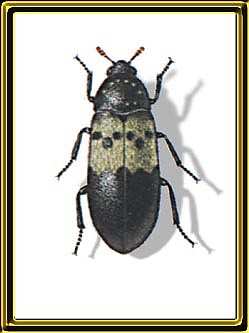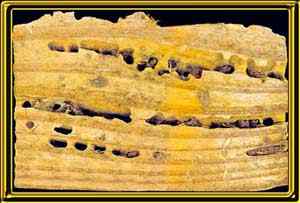
(Larder or Bacon Beetle)
All this type of beetle are of the Family Dermestidae. The members of this family live primarily on the dried remains of plants and animals. Many species live, for example, on cartilage and dried meat, and some can utilise hair and feathers. This way of life will of course bring them into contact with human interests, for they frequently attack dried foodstuffs.Description:
The adult larder beetle is dark brown and approximately 1/3 inch in length. The basal halves of the wing covers are densely covered with coarse, pale yellow hairs. Six dark spots are usually in the yellow band. The undersurface of the body and legs are covered with fine yellow hairs.
Lifecycle:
Outdoors the life cycle of this insect is regulated by the seasons; indoors it may breed continuously throughout the year. Eggs are laid in batches of 6-8, with the total per female being about 200. The larvae are dark coloured and covered with dark brown hairs. It is characterised by two curved spines on the last body segment. Like the adult, the larva is densely covered with hairs. The larvae pass through five or six moults ( five times if male, and six if female), during the 35 to 80 days of their lives. The larvae have a strong tendency to remain in dark places. Just before the larvae pupate they begin to migrate, and are often encountered by homeowners at this time. These older larvae often bore into materials such as wood, cork, or insulation looking for a place to pupate. The pupal period lasts about 15 days. The adults mate soon after emerging and eggs are laid near a food source. If conditions are ideal, a generation may be completed in 40-50 days.
Damage and Habitat:
Major damage occurs from larval feeding and the boring of the larvae before pupation. Larder beetles will attack stored ham, bacon, other meats, cheeses, tobacco, dried fish, dried museum specimens, and pet foods, for example. All of these conditions are available in, meat processing plants, renderers, butchers, fishmongers, delicatessen counters in supermarkets and, of course, beneath and behind cookers and refrigerators in the kitchen of a domestic dwelling. The larvae will bore into any commodity containing meat products; they have also been known to bore into structural timbers. Tests have shown that they can bore into lead with ease and tin with some difficulty. The boring is for the purpose of providing a protected place for pupation, not for feeding. The picture below shows damage to timber caused by larder beetle larvae boring in to pupate.
Photograph courtesy of Jim Kalisch, University of Nebraska.
Cleaning and Treatment:
Cleaning, inspection, and elimination of infested food sources are the first steps in controlling this pest. Valuable materials which are infested can be heat sterilised (140°F for 1/2 hour) or frozen (0° for 3-4 days). Place food materials that might attract beetles into tight jars or cans to discourage re-infestation. Once the cleaning has been undertaken, perhaps a light spray with a residual insecticide to wall/floor junctions and potential harbourage sites, remembering of course not to spray near food. If the infestation has been particularly bad and the business caters directly to the public, then it might be a good idea to have a contract with a pest control company so that the premises are treated and inspected on a regular basis.
Back to main Stored Product Insect page
